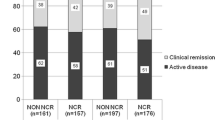Abstract
Goal of this study was to investigate whether appropriately applied spa therapy in several indications could be associated with a subsequent fall in the need for costly health services and missed working days due to sick-leave. The Naiade project was a multicenter observational, longitudinal, questionnaire-based study comparing an “entry” inquiry addressed to patients before an entry thermal cycle, and a “return” inquiry after 1 year. Routine statistical methods were used for comparisons. The study was carried out in 297 of the 340 certified Italian spa centers. Inquiries were managed by the spa doctor(s), with the collaboration of family doctors, and when necessary, hospitals, other health services, labour offices and employers. After exclusion of regular customers and of patients with acute disease phases or severe health conditions, 39,943 patients divided into eight diseases subgroups (rheumatic, respiratory, dermatologic, gynaecologic, otorhynologic, urinary, vascular and gastroenteric) underwent entry inquiry and appropriate spa treatment. Patients who returned for treatment after 1 year (“index year”) were 23,680 (59.2%) and received return inquiry. Outcomes considered were: frequency and duration of hospitalisation periods; missed working days; regular use of disease-specific drugs; and resort to “non-spa” rehabilitation therapies. The data collected at return inquiry were compared with those of entry inquiry. All the considered outcomes appeared to be significantly reduced in the index year in seven of the eight disease subgroups in comparison with the previous year. In conclusion, disease-appropriate spa treatments were followed by a reduction in the need of subsequent health interventions in most disease subgroups. The health promoting value of spa treatments should therefore undergo more rigorous assessment with randomised controlled studies.
Similar content being viewed by others
References
Aledort L, Ljung R, Blanchette V; on behalf of the International Prophylaxis Study Group (IPSG) (2006) Are randomized clinical trials the only truth? Not always. J Thromb Haemost 4:503–504
Coccheri S, Nappi G, Valenti M, Di Orio F, Altobelli E, De Luca S; on behalf of the Naiade study project (2002) Changes in the use of health resources by patients with chronic phlebopathies after thermal hydrotherapy. Report from the Naiade project, a nation-wide survey on thermal therapies in Italy. Int Angiol 21:196–200
Coiro V, Irali L, Saccani Jotti G, Varacca G, Danesino V (2003) The therapy of gynaecological diseases with salty mineral water: a branch of the “Naiade project”. Ital J Gynecol Obstet 15:88–94
De Luca S, Nappi G, Menconi Orsini A (2001) “Project Naiade”: lithiasic pathology of urinary tracts and water therapy with oligomineral waters. Med Clin Term 47:197–206
Eisenberg DM, Kessler RC, Foster C, Norlock FE, Calkin DR, Delbanco T (1993) Unconventional medicine in the United States. Prevalence, costs and pattern of use. New Engl J Med 328:246–252
Ernst E, Pittler MH (1998) How effective is spa treatment? A systematic review of randomised studies. Dtsch Med Wochenschr 123(10):273–277
Fioravanti A, Valenti M, Altobelli E, Di Orio F, Nappi G, Crisanti A, Cantarini L, Marcolongo R (2003) Clinical efficacy and cost-effectiveness evidence of spa therapy in osteoarthritis. The results of “Naiade” Italian project. Panminerva Med 45:211–217
Frost GJ (2004) The spa as a model of an optimal healing environment. J Altern Complement Med 10(Suppl 1):S85–S92
Gasbarrini G, Candelli M, Graziosetto RG, Coccheri S, Di Orio F, Nappi G (2006) Evaluation of thermal water in patients with functional dyspepsia and irritable bowel syndrome accompanying constipation. World J Gastroenterol 12:2556–2562
Mancini S Jr, Piccinetti A, Nappi G, Mancini S, Caniato A, Coccheri S (2003) Clinical, functional and quality of life changes after balneokinesis with sulphurous water in patients with varicose veins. VASA 32:26–30
Melillo G, Nappi G, Valenti M (2002) Thermal inhalation treatment of chronic lower airway diseases. Results of the NAIADE project. Ital Rev Resp Dis 17:37–42
Michalsen A, Ludke R, Buhring M, Spahn G, Langhorst J, Dobos GJ (2003) Thermal hydrotherapy improves quality of life and hemodynamic function in patients with chronic heart failure. Am Heart J 146:728–733
Ministero del Tesoro, del Bilancio e della Programmazione Economica. Relazione Generale sulla situazione economica del Paese, anno 1998 (Rapporto sanità 1998) (1999) Roma, Istituto Poligrafico dello Stato
Morita E, Weigl M, Schuh A, Stucki G (2006) Identification of relevant ICF categories for indication, intervention planning and evaluation of health resort programs: a Delphi exercise. Int J Biometeorol 50:183–191
Rossi A, Cantisani C, Carlesimo M, Calvieri S (2003) Terme e cute. G Ital Dermatol Venereol 138:519–524
SAS Institute (1996) SAS/STAT Software: release 6.11, Cary NC: SAS Institute
Strauss-Blasche G, Ekmekcioglu C, Vacariu G, Melchart H, Fialka-Moser V, Marktl W (2002) Contribution of individual spa therapies in the treatment of chronic pain. Clin J Pain 18:302–309
Stucki G, Ewert T, Cieza A (2003) Value and application of the ICF in rehabilitation medicine. Disabil Rehabil 25:628–634
van Tubergen A, van der Linden S (2002) A brief history of spa therapy. Ann Rheum Dis 61:273–275
van Tubergen A, Landewe R, van der Heijde D, Hidding A, Wolter N, Asscher M, Falkenbach A, Genth E, The HG, van der Linden S (2001) Combined spa-exercise therapy is effective in patients with ankylosing spondylitis: a randomized controlled trial. Arthritis Rheum 45:430–438
van Tubergen A, Boonen A, Landerwe R, Rutten-van Molken M, van der Heijde D, Hidding A, van der Linden S (2002) Cost effectiveness of combined spa-exercise therapy in ankylosing spondylitis: a randomized controlled trial. Arthritis Rheum 47:459–467
Verhagen AP, De Vet HC, De Bie RA, Kessels AG, Knipshild PG (2003) Balneotherapy for rheumatoid arthritis and ostheoarthritis. Cochrane Database Syst Rev (4):CD000518
Acknowledgements
The Naiade project collaborative group also included: A. Abramo, E. Altobelli, M. Anti, G. Busellu, A.O. Carlesimo, A. D’Alessandro, V. Danesino, S. De Luca, E. Ercoli, A. Fioravanti, R. Marcolongo, T. Marullo, F. Masedu, R. Melillo.
Author information
Authors and Affiliations
Corresponding author
Rights and permissions
About this article
Cite this article
Coccheri, S., Gasbarrini, G., Valenti, M. et al. Has time come for a re-assessment of spa therapy? The NAIADE survey in Italy. Int J Biometeorol 52, 231–237 (2008). https://doi.org/10.1007/s00484-007-0117-4
Received:
Revised:
Accepted:
Published:
Issue Date:
DOI: https://doi.org/10.1007/s00484-007-0117-4




